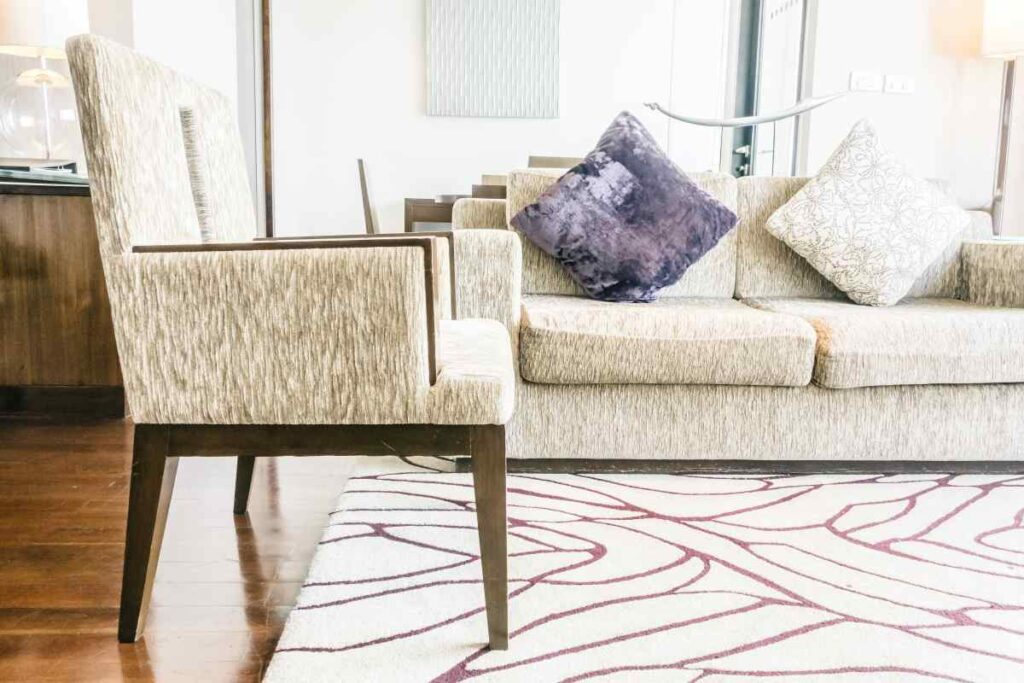For a living room rug, typical sizes are 8’x10′ and 9’x12′. The rug should be at least 6-8 inches wider than your sofa on both sides.
It should also be large enough that the entire front of the couch is on it, and at least two legs of all other furniture in the room are on the rug. To visualize the rug size in your living room, measure out the desired size with painter’s tape.
If you have a small living room, consider leaving a 12 to 18-inch border between the rug and the walls.
Are There Any Other Factors To Consider When Choosing The Size Of A Living Room Rug Besides The Size Of The Furniture?
Yes, there are other factors to consider when choosing the size of a living room rug besides the size of the furniture.
These factors include the size and shape of the room, the placement of furniture, and the amount of space you want to leave around the rug.
For example, it is recommended to leave at least 12 inches of breathing room around the rug and to ensure that the rug is at least 6-8 inches wider than your sofa. Additionally, the shape of the rug should echo the shape of the furniture in the space.
It is also important to measure the space before buying a rug to ensure that it fits comfortably.
Can A Larger Rug Be Used In A Small Living Room, Or Is It Better To Stick To A Specific Size?
A larger rug can be used in a small living room to make it look bigger.
It is recommended to use one large area rug that extends beyond the furniture in each functional space.
However, it is important to choose the correct rug size to avoid making a common decorating mistake.
Additionally, it is suggested to choose a light-colored rug with little or no texture and almost no pattern to open up the space.
Creating an illusion with lines and placing rugs on either side of the room with one larger than another can also make a small space look bigger.
How Can One Determine The Best Placement For A Living Room Rug In Terms Of The Furniture Layout?
To determine the best placement for a living room rug in terms of furniture layout, there are several guidelines to follow:
- Leave approximately 18 to 24 inches of space around the rug and avoid encroaching on any walkways
- In a slightly larger space, place the front legs of your furniture on top of the area rug
- In a living room, all of the furniture should be on top of the rug.
If this isn’t possible, it’s okay to have the front legs of the furniture on the rug - Ideally, you want a rug that will fit all four legs of each piece of furniture on the rug.
Leaving about four to eight inches of floor bordering - Keep anywhere from a foot to a few inches between your furniture and the edge of the rug.
This arrangement works best in large, open spaces
What Are Some Alternative Shapes For A Living Room Rug Besides Rectangular, And How Do They Affect The Size Selection?
In addition to rectangles, other options for living room rugs include round, square, and oval.
Because it relies on the design of the space and the location of the furniture, the form of the rug might influence the size choice.
A square rug may be utilized to designate a seating area in an open-concept room, whilst a circular rug can work well in a compact space or to create a comfortable seating area.
The size of the room, the location of the furniture, and the overall appearance and feel of the area should all be taken into account when choosing a rug size.
Is It Necessary For The Living Room Rug To Match The Color Scheme Of The Furniture And Walls, Or Can It Be A Contrasting Color Or Pattern?
There are varying opinions on whether a living room rug should match the color scheme of the furniture and walls or if it can be a contrasting color or pattern.
Some sources suggest that the rug should complement the color scheme of the room to tie the look together.
Others suggest that the rug can dictate the color scheme of the room or vice versa and that the choice of rug can completely change the tone of a room.
Ultimately, the decision is up to personal preference and the desired aesthetic of the room.







